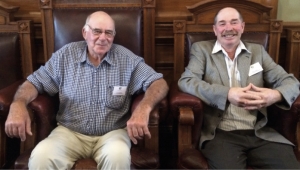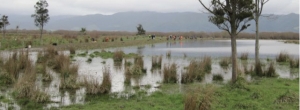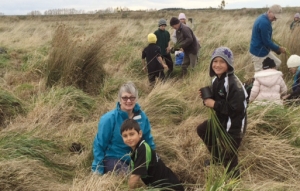Displaying items by tag: Wairio
Wairio under scrutiny
Ecological restoration of Wairio Wetland, Lake Wairarapa
The response of native wetland vegetation to eutrophication and re-vegitation management strategies.
Wetlands are highly productive ecosystems that support abundant native fauna and flora and provide many essential functions and services, for example, water purification, erosion stabilisation, floodwater storage, groundwater recharge, peat accumulation and biogeochemical cycling.
Wetland disturbance can cause altered hydrological regimes, invasive species introduction, soil and water eutrophication, habitat fragmentation and reductions in native fauna and flora leading to an overall reduced functionality.
Wairio Wetland on the eastern shores of Lake Wairarapa forms a part of Wairarapa-Moana, the largest wetland complex in the lower North Island. Historically Wairio was an abundant kahikatea swamp forest, with a diverse range of waterfowl, waders and freshwater fish. However, the wetland was adversely affected by a draining scheme during the 1960s and 1970s, the construction of Parera Road, and the invasion of willow trees planted for erosion control.
Draining of the wetland, division from nearby lagoons and ponds, nitrogen and phosphorus build-up in waterways and exotic weed invasion all contributed to the poor state of the wetland. In 2005, Ducks Unlimited (DU) in conjunction with the Department of Conservation (DOC) and members of the local community formed the Wairio Wetland
Restoration Committee to manage and restore the wetland to its presettlement state.
This thesis reports on two studies undertaken at Wairio Wetland with aims to inform future restoration efforts.
The short duration of the experiment and summer drought conditions may have obscured the above-ground visual responses of the plant community to nutrient addition: therefore, further continuation of this experiment is advised. Variable survival rates of previous plantings, and uncertainty about the most cost-effective practice under current site conditions, provided the impetus for this study.
Therefore the second study, conducted between July 2011 and January 2014 in Stage 3 of the wetland, further investigates the effects of various management treatments on establishment of native woody vegetation.
Note: Both the experiments described in the above thesis are on-going. Stephen Hartley who is Deputy Director for the Victoria University Centre for Biodiversity and Restoration Ecology and is a Senior Lecturer in Conservation and Ecology, will continue to monitor the growth of trees in Stage 3, and a Belgian intern student will re-survey the nutrient enrichment plots in Stage 2.
To view Aprille Gillon’s full thesis go to:-
http://researcharchive.vuw.ac
Results showed that interspecific competition and hydrology appeared to be the main processes influencing the establishment of native plantings at Wairio Wetland, with plant mortality greatest in the first year after planting. Water logging, in particular, was detrimental to establishment of all species at the site except D. dacridioides. Topsoil excavation and the planting of nurse trees at 1.5m spacing was the most effective management treatment combination promoting survival of plantings at Wairio.
However, the success of management treatments varied greatly between species at the site and had different impacts on plant growth. Topsoil excavation was beneficial to survival of D. dacridioides and C. robusta but detrimental to growth of C. australis, O. virgata, C. propinqua, Ptenuifolium and L. scoparium.
The concurrent planting of nurse trees with focal trees was beneficial to the survival of D. dacridioides, growth of P. totara, and survival and growth of C. australis. The planting of nurse trees further apart at 1.5m compared to 0.75m had a positive effect on the survival of C. propinqua and P. tenuifolium, and survival and growth of L. scoparium. Weed mats were beneficial to survival of O. virgata and growth of L. scoparium but detrimental to growth of D. dacridioides. These management treatments can be used in future revegetation efforts at Wairio Wetland and potentially in other wetland restoration projects throughout New Zealand.
Boggy Pond April rounds
Working in the edge of the wetlands
Wairio Wetland planting continues
This type of habitat is an ideal breeding and feeding area for a wide variety waterfowl such as swan, geese, bittern, royal spoonbill and of course ducks.
The Bund has been fenced to keep stock out as well as protect planting.
A planting day, held on April 21 was attended by about 40 people including students from a local school and Taratahi Agricultural College, members of the South Wairarapa Rotary and a variety of people from DU, Greater Wellington Council and the local district.
We received $2500 worth of plants from the Honda Fund, as well as three people from Southey Honda in Masterton to help with the planting.
Start time was 10am and 2000 plants were in the ground by 12 noon, just in time for lunch provided by Greater Wellington Regional Council.
Special thanks go to The Game Bird Habitat Trust, Greater Wellington Regional Council, Nikau Foundation, Pharazyn Trust and South Wairarapa Rotary Club for their generous sponsorship.
It was an excellent day my thanks to all involved.
We now await rain to see just how successful we have been.
Ross Cottle
Wairio scores again
Thanks to the Nikau Foundation, Wairio wetland has again been granted a generous amount toward development for the wetland. The Richard and Doreen Evans Charitable Trust provided $4000 in the 2015 Nikau Foundation funding round.
Conditions placed on the grant:
- It must be used for the purpose applied for.
- The Trust must receive a feedback form from within a year of the grant being made.
- The Trust requires an update of progress towards completion of the project. Also forward two or three photos and an update that can be used on their website / annual report / newsletters. Before and after photos are especially welcome with captions. Talent release permissions are DUNZs responsibility.
- Please acknowledge Nikau Foundation contribution to DUNZ in any publications or any other means of release – The Foundation would like to become better known throughout the Wellington region.
- Our logo is available to use in your publications.
- Please keep informed through our website and “Like” us on facebook.
Should any of you wish to know more go to the Foundation’s web site, www.nikaufoundation.org.nz.
New GM
The Nikau Foundation has appointed a new General Manager who brings a wealth of experience from the community and voluntary sector. Louise Parkin has had 25 years working with charitable and philanthropic organisations both in New Zealand and internationally.
Ms Parkin had been at Nikau Foundation as their Philanthropy Advisor for six months before taking up the role of General Manager in January this year.
In her spare time, she teaches the Japanese martial art of aikido to adults and children. Her personal philanthropy is for the benefit of the environment and international aid.
The Nikau Foundation is part of a world-wide network of community foundations set up to benefit a specific geographic area, in this case the Wellington region. The Foundation manages 22 endowment funds that benefit the arts, education, social and youth projects, the environment and beyond. It does this through the generosity of local donors. The funds it manages grew 100 percent in the last year.
Wairio restoration planning and farewell
The presentation of DUNZ’s certificate “in recognition and appreciation of support to NZ’s waterfowl and wetland habitat” to Ian Gunn from Greater Wellington Regional Council (GWRC) – Manager of GWRC’s Wairarapa Moana Project and a great supporter of the Wairio Wetland Restoration Project.
Ian was critical in securing a “step change” in funding for the project. The presentation was made at the end of the meeting along with the small gift of a bottle of wine. DUNZ members may recall Ian joining us at our 2014 AGM in Martinborough.
The recent meeting was held at Fish & Game’s Kilmore Lodge, adjacent to the Wetland where the group planning the 2016 work programme was underway.
Funding currently tots up to around $30,000. Of this, about $20,000 is already funded by contributions from our supporters.
Wairio wetland plant day – another success
June 21 work started at 9am for the organisers, supported by some strong lads from Taratahi Agricultural Training College and farm workers from a local sheep and beef station Palliser Ridge. Those strong farming trainees dug holes in pre-sprayed spots in rough, fescue infested terrain.
Just after 10am we also had about 20 school children from Martinborough and Kahutara primary schools arrive to “assist” in planting flaxes in the holes prepared by the aforementioned lads and workers. In all, around 65 folk helped with the planting and by 12 noon, 750 plants (about half of them kahikatea) were in the ground at the noreastern corner of the Wetland.
Greater Wellington Regional Council provided educational support and the school children, in addition to planting, were treated to a field class identifying plants common to the Wetland. That and the hot sausages for lunch (again provided by GWRC) made a great day for the children who said they would be back next year to see how “their” plants were growing.
Jim Law.
BirdsNZ members brave the weather
The weather was not wonderful, but Robin and Heather List are seasoned birders and the pair set off to Wario to check on birds and do a count.
Robin said “The expedition consisted of Heather and me. We have the gear and do wetlands in squalls right cheerfully, so there was no grumbling in the ranks, though the waterproof notebook was abandoned in favour of the little recorder, which worked well under wet, windy conditions. The sun broke through at times and the whole place was looking grand as wetlands in winter can.
“There wasn’t a feather of a Dabchick nor yet a Bittern to be seen, so we’ll go looking in other haunts. It is possible they haven’t read the books and aren’t breeding yet, but it has been a mild winter.
“What we did see or hear in the space of 2 hours 10 minutes, not counting the walk along the road back to the car was, here in random order.”
Black swan 135,
Mallard X Grey 26, (possibly a couple of Shovellers among the tussocks at the sheds pond, but I think they prefer Boggy Pond)
- Teal 25,
- Yellowhammer15,
- Harrier 4,
- Blackbird 4,
- Welcome Swallow 6,
- Pukeko 6,
- Magpie 4,
- Kingfisher 3,
- Silver-eye 37,
- Goldfinch 15,
- Black Shag 1,
- Skylark 2,
- Spurwing Plover 5,
- Grey Warbler 1
All up16 species were seen by this intrepid pair, who also had an enjoyable lunch and excellent company in beautiful surroundings.
“Who could ask for more?” said Robin.
Wetland Impresses
The Wairio Wetlands were on the list for the 200 members of the New Zealand Farm Forestry Association being hosted by the Wairarapa branch for their 55th annual conference.
Our own DU member and director, John Dermer is currently their national president. Wairarapa Farm Forestry president Stu Orme, and secretary Shane Atkinson, were thoughtful enough to write to Jim Law and thank him for hosting their field trip to Wairio:
“We would like to thank you for the effort you put in to host our field trip to the Wairio wetlands. Your restoration project directly addresses all three themes of our conference and is an outstanding example of a local initiative on a grand scale. Lake Wairarapa dominates the whole of the lower valley and the re-creation of wetlands along the degraded eastern boundary is a task with very long-term benefits. All our visitors enjoyed their trip. Thank you again.”
John Dermer said that all 200 of the NZFF conference attendees visited Wairio.
“We visited Castle Point Station in the north and down to the southern end to Prinoa Station and Waiorongomai on our last day with a look at Wairio and a talk from Jim Law.”
John said that once again he was struck by the sheer size of the Wairio Wetland although it was living up to its name, 'dry water' at the time. “Jim told us about the weed issues, mainly tall fescue, which makes getting trees established more difficult and the answers we are trying to find. One thing I noticed was how well plants are managing on the piles of soil excavated, so my main question is Why not do more? “There must be a shallow water table underneath so why aren’t we digging deeper? “What is the point of digging holes so shallow they don’t hold water?” John said there is no way he would site his maimai on this bit of dry wetland. He said he is sure the Farm Foresters were impressed, and they certainly asked lots of questions.
John Dermer



